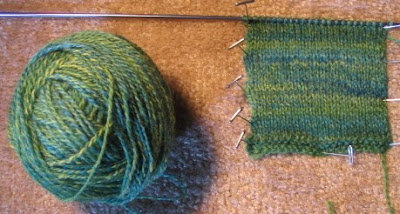
Washing didn't improve the yarn's loft, so it remained 16 WPI after washing.
Cathy asked
 Yes indeed it does look tweedy, and that was what I was going for. This yarn was plyed from a center pull ball, so that the various colors of the single mix and match at random. I could have gotten the same effect by plying two bobbins of it.
Yes indeed it does look tweedy, and that was what I was going for. This yarn was plyed from a center pull ball, so that the various colors of the single mix and match at random. I could have gotten the same effect by plying two bobbins of it.
Yarns like this can be subtle if the colors are from the same quarter of the color wheel (analogous) and of similar value (lightness or darkness), or bold if they have more contrast in either color or value.
To get a variegated yarn with purer looking colors, the singles would need to be Navajo plyed. This technique actually chains the singles, much like crochet, so that the individual colors ply on themselves. The result is a 3-ply yarn. Since I still have the painted Norwegian roving to spin, I may ply it in that fashion. That will give me two yarn looks in the same color scheme.
At this point I don't know what I will use this particular yarn for. The modern Texel sheep was developed in Norway from an old British breed. It's wool ranges from medium (being suitable for knitted or woven outer garments) to coarse (which is used for rugs and carpets). My sample is not next-to-skin wearable, but would do nicely for a vest or sweater. I won't have enough yardage for either of those, but mixed with something similar, I might be able to do it. We'll see.
Cathy asked
When you paint the roving do you have any sense of how it's going to turn out once spun? I was imagining something more like variegated yarn, but this is sort of tweedy....
 Yes indeed it does look tweedy, and that was what I was going for. This yarn was plyed from a center pull ball, so that the various colors of the single mix and match at random. I could have gotten the same effect by plying two bobbins of it.
Yes indeed it does look tweedy, and that was what I was going for. This yarn was plyed from a center pull ball, so that the various colors of the single mix and match at random. I could have gotten the same effect by plying two bobbins of it.Yarns like this can be subtle if the colors are from the same quarter of the color wheel (analogous) and of similar value (lightness or darkness), or bold if they have more contrast in either color or value.
To get a variegated yarn with purer looking colors, the singles would need to be Navajo plyed. This technique actually chains the singles, much like crochet, so that the individual colors ply on themselves. The result is a 3-ply yarn. Since I still have the painted Norwegian roving to spin, I may ply it in that fashion. That will give me two yarn looks in the same color scheme.
At this point I don't know what I will use this particular yarn for. The modern Texel sheep was developed in Norway from an old British breed. It's wool ranges from medium (being suitable for knitted or woven outer garments) to coarse (which is used for rugs and carpets). My sample is not next-to-skin wearable, but would do nicely for a vest or sweater. I won't have enough yardage for either of those, but mixed with something similar, I might be able to do it. We'll see.
© 2007 Leigh's Fiber Journal
Related Posts:
A Day for Painting Roving - how I painted this roving
A Change of Spinning Plans - how this painted roving spun up

3 comments:
After I left my comment I realized the look you got was because of the plying and then I couldn't figure out how you'd get a variegated look - now I get it! I guess Navajo plying is sort of like chaining a warp too! Found this little video which demonstrates Navajo plying.
Silly me - I thought Texel was a synthetic. How about weave with it. Does your sofa need any pillows?
Beautiful!
Post a Comment